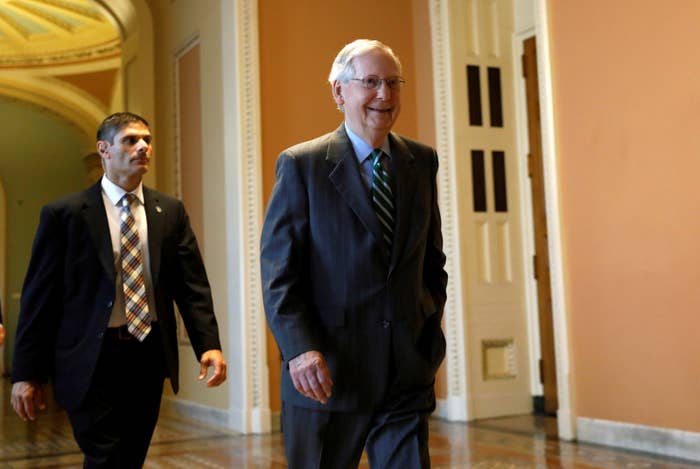
Despite talk of starting from the drawing board, the Senate’s draft bill to repeal and replace Obamacare greatly resembles the House bill that came before it.
Both bills would mean less robust coverage and more out-of-pocket costs for poorer Americans compared to Obamacare. They would also repeal federal funding for Planned Parenthood, and divert hundreds of billions of dollars out of Medicaid and into tax breaks for wealthy Americans.
The Senate plans to vote on its bill next week, after just three days of planned debate on the Senate floor. Assuming that it passes — which is far from assured at this point — Senate Republicans will then have to work out their differences with the House to come up with a final bill to send to President Donald Trump to be signed into law.
Here are the biggest things the House and Senate disagree (and agree) on:
What are Republicans going to do about pre-existing conditions?
The Senate bill would keep Obamacare's protections for people with pre-existing conditions. The House bill would let states waive these protections, and allow insurers to charge people more based on their health conditions. The Senate nixed that idea, but its bill would essentially let states waive all other Obamacare rules, including basic things insurance plans must cover — like hospitalization, maternity care and prescription drugs — as well as caps on out-of-pocket costs. Governors would also be able to apply for these waivers without going through state legislatures.
So while someone who is chronically ill cannot be denied insurance under either the House or Senate plan, less expensive insurance options could lack the coverage they need, or come with huge out-of-pocket costs.
Will people have to get insurance or be charged more for going without insurance?
Loosening Obamacare regulations should bring down premiums for healthy people. But the Senate bill does not contain one favored measure to bring down premiums — incentivizing healthy people to buy insurance. Obamacare had the “individual mandate” that fined people for not buying insurance. The House bill contains a continuous coverage rule, to let insurance companies raise prices for people who have lapses in their insurance coverage. The Senate bill says nothing along these lines.
In theory, there is nothing in the Senate bill to prevent people from forgoing health insurance when they are healthy, and only buying it when they get sick. This would mean fewer healthy people on insurance rolls, and higher prices for everyone else. Senate GOP staffers seemed to acknowledge this problem on Thursday, and said they are in talks with the Congressional Budget Office to add language similar to the House bill. They didn’t say why the language was not included in Thursday's draft, but it could be because they suspected it would breach Senate rules.
What will happen to costs for low-income people?
The Senate bill targets insurance subsidies to lower-income Americans, which the House bill does not do. But it also opens the door for poor people to face significantly higher out-of-pocket costs.
The House bill would provide between $2,000 and $4,000 a year to help a person buy insurance depending on that person’s age, but not taking into account their income — meaning that people of the same age would receive the same amount of money whether they were middle class or barely above the poverty line. The Senate bill targets those subsidies at lower-income people, just as Obamacare did.
But there are two key changes. The Senate’s subsidies cut off at a lower income level — 350% of the federal poverty level compared to 400% for Obamacare, or $41,500 vs. $47,500 for an individual — and they also loosen how much those insurance plans must cover. That would allow out-of-pocket costs to jump by one-third for people who rely on the subsidies.
What will they do about abortion?
The House and Senate bills contain two identical anti-abortion provisions. First, both would strip all federal funding from Planned Parenthood. This means Medicaid patients would not be covered for a procedure at a Planned Parenthood-affiliated clinic, even if the procedure was not abortion-related.
Second, both bills prohibit the individual tax subsidies mentioned above from paying for insurance plans that cover abortion procedures — whether the insured person gets the procedure or not.
What will happen to Medicaid?
Both the House and Senate bills would roll back the Obamacare expansion of Medicaid — the publicly-funded insurance program for low-income people, the disabled, and children — and both plans would cap the program’s funding. The Senate bill would roll back the expansion over a longer period than the House bill would — from 2020 in the House bill to 2024 in the Senate’s version — but would ultimately level stricter caps that should mean billions less in long-term funding.
The House bill would cut $830 billion from Medicaid over the next decade, according to the Congressional Budget Office. The Senate bill has not yet been scored in the same way, but will likely be in the same ballpark. Both bills would use that money to pay for about $660 billion in tax cuts that would overwhelmingly benefit people who earn over $200,000.

